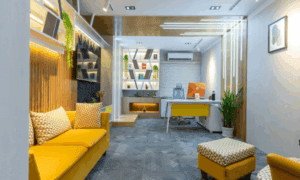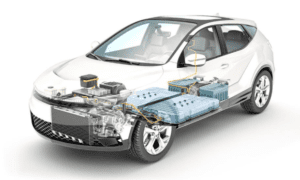A leading specialist in HVAC engineering, explores the key aspects of ventilation, heating, and air conditioning systems that must be considered when designing and operating a restaurant.
On March 9, the Cases & Faces awards concluded, highlighting innovations that enhance efficiency, sustainability, and energy optimization across various economic sectors. Special attention was given to industries with consistently high energy consumption, such as the restaurant business, which continues to grow at a rapid pace. According to forecasts, the full-service restaurant market in the U.S. is valued at $324.90 billion in 2024 and is expected to reach $554.12 billion by 2029, with an average annual growth rate of 11.27% over the forecast period. At the same time, both Europe and the U.S. have been tightening energy efficiency standards for heating, ventilation, and air conditioning (HVAC) systems. In the U.S., all new air conditioning systems and air-source heat pumps must now comply with modern energy efficiency regulations.
To meet these standards, it is crucial to design advanced and efficient HVAC systems. We spoke with Roman Abakumov, who recently won a Cases & Faces award in the category “Achievement in Engineering: Consumer Services,” about how to approach this challenge from a technical and practical standpoint. Roman Abakumov has extensive experience working with leading global companies and brands, such as VIESSMANN, REHAU, VAILLANT, GRUNDFOS, MEIBES and others. He has been involved in the implementation of government and private projects, utilizing partner equipment and developing solutions to reduce energy consumption. In this article, we will explore the best practices for HVAC system design using the example of the restaurant “Davai na TY”, where Roman was responsible for all HVAC engineering solutions.
“Davai na TY”: A smart approach to HVAC design
Modern restaurant businesses require not only well-designed spaces and high-quality service but also advanced engineering infrastructure. HVAC systems play a key role in ensuring guest and staff comfort while optimizing energy consumption. Properly designed HVAC systems help reduce operational costs and improve sustainability, aligning with the latest energy efficiency standards. The Davai na TY restaurant is an example of how innovative HVAC solutions can be integrated with a sustainable development strategy. This project successfully implemented advanced approaches to ventilation, heating, and climate control, reducing energy consumption while maintaining a comfortable atmosphere for visitors.
“Efficiency in HVAC design is not just about power—it’s about how systems interact. At this project we focused on seamless integration between ventilation, heating, and air conditioning, reducing peak energy loads while maintaining a stable and comfortable indoor climate.” — Roman Abakumov, Lead HVAC Engineer and Project Specialist.
Ventilation and air filtration: Keeping the air clean and odor-free
Restaurant kitchens produce a significant amount of heat, steam, and odors, which can spread into dining areas and affect the overall guest experience. Proper HVAC design ensures effective airflow management, air purification, and heat recovery to improve air quality while reducing energy consumption. Key elements include installing high-efficiency exhaust hoods, integrating ventilation with air conditioning for balanced airflow, and using heat recovery technologies to enhance efficiency. At Davai na TY, a supply and exhaust ventilation system from brand Vents was installed with heat recovery technology, effectively removing kitchen emissions while minimizing energy losses. This system maintains fresh air throughout the restaurant, ensuring a comfortable environment for both guests and staff.
“One of the most common mistakes in restaurant HVAC design is underestimating ventilation capacity. At Davai na TY, we carefully analyzed the real heat loads and airflows, which allowed us to reduce energy consumption by 15% compared to conventional setups.” — says Roman.
Heating: A multi-zone system for seasonal efficiency
A restaurant’s heating system must maintain a comfortable indoor climate while adapting to seasonal variations. Different areas — such as the kitchen, dining hall, and storage rooms — require different heating approaches to ensure efficiency and prevent energy waste. A well-planned system includes multiple heat sources, automated temperature control, and energy-saving features to optimize costs and performance.
A hybrid heating solution was implemented at this restaurant, incorporating a Vaillant heat pump, a Protherm electric boiler, and a ventilation-integrated heating module. This system ensures flexible heat distribution, automatically adapting to outdoor temperatures and guest occupancy to minimize excess energy consumption.
“A common issue in restaurant heating is overheating in the kitchen while guest areas remain too cold. Our system dynamically adjusts heat distribution based on real-time demand, lowering energy use while ensuring an even temperature throughout the space”— comments expert.
Air сonditioning: Maintaining a stable indoor climate
Efficient air conditioning is vital for guest comfort, particularly during peak hours when indoor temperatures fluctuate due to high occupancy. Poorly designed HVAC systems can result in uneven cooling, leading to discomfort. The key to effective air conditioning is integrating it with the ventilation system, using automated controls, and ensuring balanced airflow distribution. At restaurant a multi-zone air conditioning system was introduced, equipped with smart sensors that adjust cooling levels based on real-time occupancy and external weather conditions. This ensures consistent indoor temperatures, preventing discomfort caused by cold drafts or overheating.
“For balanced cooling in a restaurant, it’s essential to consider airflow distribution based on seating layouts, kitchen heat output, and natural circulation. For example, we can use Computational Fluid Dynamics modeling to determine optimal air conditioning placement, ensuring that no areas were overcooled or overheated, creating a consistently comfortable environment for guests.” — Roman shares.
Intelligent automation: Real-time climate control
Automating HVAC systems in restaurants is essential for optimizing energy use and maintaining a stable indoor climate. A properly designed system should adjust ventilation, heating, and cooling based on occupancy, kitchen activity, and external weather conditions. The key is choosing the right combination of sensors and control mechanisms, such as CO₂ sensors to regulate fresh air intake, humidity sensors to prevent moisture buildup, and smart thermostats for precise temperature adjustments. As part of this design, Roman Abakumov integrated a centralized HVAC control system that enables real-time monitoring and automated adjustments. The system dynamically responds to changing conditions, ensuring energy efficiency without compromising comfort.
«Beyond installing sensors, it’s important to program HVAC automation correctly. For example, CO₂ sensors should be calibrated to trigger fresh air intake only when occupancy reaches a critical threshold, preventing overuse of ventilation. Similarly, humidity sensors must be positioned strategically—too close to kitchen zones, and they’ll misread levels, leading to unnecessary dehumidification», — the expert advises.
Sustainability: Integrating energy-saving technologies
Sustainability is no longer just an option in restaurant HVAC design—it’s a necessity for reducing environmental impact and improving long-term cost efficiency. Thoughtful planning includes evaluating how to minimize energy waste, optimize resource consumption, and implement eco-friendly solutions without compromising operations. Key strategies include sourcing materials and ingredients locally to lower the carbon footprint, investing in waste management systems to reduce excess energy loss, and adopting high-efficiency equipment to streamline daily operations. In this restaurant, Roman Abakumov implemented a range of sustainability-focused technologies, including energy-efficient HVAC systems, LED lighting, and an advanced energy monitoring system that tracks usage in real time. Additionally, a structured waste management program was introduced to minimize unnecessary energy expenditures while ensuring efficient operations. These efforts reduced the restaurant’s environmental impact and allowed cost savings to be reinvested in enhancing service quality and innovation.
Anyone considering using commercial spaces for the restaurant business should take these best practices into account. Today, there are more questions than ever about how restaurant spaces should be organized to maximize efficiency, sustainability, and cost-effectiveness. The case and the insights shared by Roman Abakumov offer valuable guidance for those looking to avoid common challenges and optimize their HVAC systems. Thanks to Roman’s expertise in integrating energy-efficient solutions, the restaurant has achieved a consistent increase in revenue, with an average monthly turnover of $50,000. Additionally, the restaurant operates with 30% lower energy costs compared to traditional restaurants, a direct result of its well-designed HVAC system, energy-efficient kitchen, and optimized lighting solutions. By applying these strategies, restaurant owners and operators can ensure seamless operations, reduce unnecessary expenses, and create a comfortable environment for both guests and staff.



































